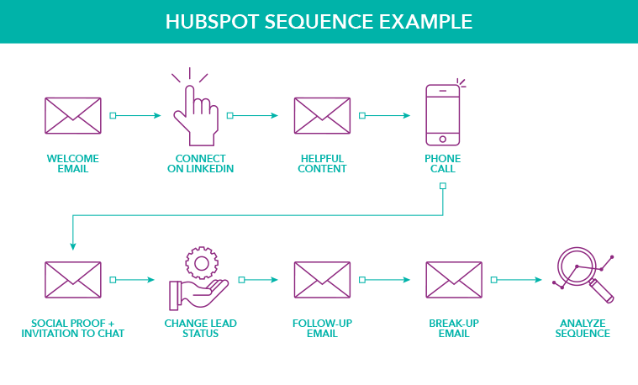Sequences
Being a successful sales team means to dedicate countless hours emailing, reaching out to contacts on social media, and making phone calls. Sales people do this because they know that, even with SQL, it takes perseverance and several touchpoints to have that conversation that closes deals.
The question now is, how many touchpoints? The number varies as every prospect is different, but statistically, across a broad spectrum of data, that number is around eight. So, when you surpass eight touchpoints, the law of diminishing returns comes into play. So, how do busy sales and marketing professionals keep their heads over their shoulders when implementing outreach campaigns? The answer is automation, and in this instance, automation comes in the form of sales sequences.
How can Kulture Konnect support your sequences efforts?
Sales Sequences are automated a series of targeted, timed email templates that help your salespeople manage their outreach better and nurture contacts over time. We can help you with:
Strategy
Before setting up your sequences, it is important to know your strategy. We can help you identify whether you’re introducing your company and services or re-engaging with current customers.
Setting up sequence and tasks
A sequence is nothing without action steps. We can help you set up your sequences by creating customizable templates and assigning tasks to keep your follow up on point.
Contact us now to pick our brains about how to get your sequences program started.
LET’S WORK TOGETHERWhat does a sales sequence look like?
A sales sequence can and should look different depending on your audience segment, the buyer’s journey stage and your final goal. For example, you might have a sales sequence that works as an introduction to your company and services, another one that works as an engagement sequence where you can share valuable resources or a conversion sequence where they can take action to contact you right away. Here’s an example of a sales sequence that incorporates all three of those:
- Email 1: Intro email
- Task 1: Connect with prospect on LinkedIn and research prospect’s other social media channels
- Email 2: Share valuable resources
- Task 2: Phone call
- Email 3: Invitation to chat
- Task 3: Change lead status
- Email 4: Follow-up Email
- Task 4: Follow up phone call
- Email 5: Follow up email with additional valuable resources
- Email 6: Break-up Email
- Task 5: Analyze Sequence

A sequence like this allows you to provide a personalized experience while automating some of the more tedious tasks your sales team deals with.
Learn more about how we can support you in streamlining your sales sequences efforts.
LET’S START THE CONVERSATIONIs a sequence the same as a workflow?
There are two different ways to automate emails: sequences and workflows. Although both can send contacts a series of emails, there are some major differences to be aware of:
Types of email
Sequences send emails from your connected inbox as sales emails, while workflows use marketing emails from MQLs that are saved for automation and the “from” address can be customized in the email editor.
Email templates
Both sequences and workflows use templates. However, when creating sequences, you are using sales email templates, while workflows can either be created in a drag and drop editor or using a marketing email template.
Enrollment
Sequences only allow for manual enrollment because they are intended to consist of more targeted emails that will result in a reply or a booked meeting. Workflows have automatic and manual enrollment and you can set triggers that allow contacts to get enrolled in any given workflow once they meet those triggers.
Unenrolling
Sequences only allow you to unenroll any given contact automatically once the contact replies to an email or books a meeting. On the other hand, workflows DO NOT automatically unenroll contacts and in order to stop executing the workflow you have to specify a goal criteria.
Tracking
Sequences are sales emails and workflows are marketing emails, therefore, they track different things. Sales emails track when a contact replies to the email or when there is a meeting booked, which is why the sequences can unenroll the contacts. Marketing emails CANNOT track email replies.
While sales sequences are used by sales teams to establish a connection with a lead through a series of follow-ups once a 1-1 relationship has been established and closing deals on SQLs, workflows are used by marketing teams for nurturing new leads in earlier stages of buyer journey from activities like website signups, field property changes, etc.
The purpose of having a sales sequence is to add value for your prospects and build a relationship they can trust. They can be a powerful tool for your sales team to automate certain tasks in the sales process, interact with prospects and close more deals.
Contact us now to pick our brains about how to get your CRM program started.
LET’S WORK TOGETHER
